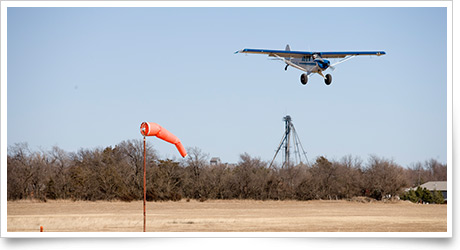| The following stories from the May 04, 2012, edition of AOPA ePilot were provided to AOPA members who expressed an interest in the particular subject areas. Any AOPA member can receive information tailored to their areas of interest by updating their preferences online |
training tipsThe inflammatory response The traffic pattern is full, and now the tower instructs you to extend your downwind and await instructions to turn base after a heavy aircraft has passed. The wind’s up too, with gusts that exceed the limitations inscribed by your flight instructor in your logbook before your first solo. Feeling the pressure? Now all you want to do is get the trainer back to the flight school’s ramp as soon as you can. “Better make this landing a good one, winds and all,” you say to yourself. Time out! Any situation that generates pressure unrelated to the immediate needs of a flight can be a pilot’s first exposure to a land-at-all-costs mindset that can put you in a bad spot: Distracted by pressure, or guilt, a pilot may succumb to the external distractions and ignore flight hazards, sometimes resulting in a mishap. Down in the pilot’s lounge, this unsafe state of mind goes by names like “get-down-itis,” “get-there-itis,” or “landingitis.” They borrow the suffix “itis” from medical terminology, where it refers to inflammation. In a March 2005 Flight Training article, airline pilot Karen M. Kahn described it as “a mindset that leads us to believe we have to land when we arrive at the destination.” Don’t let your priorities get scrambled as a result of anxiety about non-flight-critical concerns such as running behind schedule. Minor mechanical glitches, low fuel, or approaching bad weather can also trigger the response. The Air Safety Institute’s Do the Right Thing online course is a helpful way to keep good decision making at the forefront of your flying. Remember: Fly the airplane! If you need to perform a go-around, don’t let the call be influenced by a mental image of another pilot waiting impatiently for the absent trainer at the tiedown spot. Narratives abound of loss-of-control accidents such as this one caused by the pilot’s preoccupation with complying with ATC instructions despite a high, fast approach. Apologize for running late, or make amends by taking the other trainee to lunch—but don’t inflame the situation with a bad call in the cockpit. training productsMarv Golden lighted red LED penA red-lens flashlight is a handy cockpit companion for night flying, since red light preserves your night vision. Here’s a red light-emitting diode (LED) pen from Marv Golden. The LED illuminates the barrel of the pen and gives you front-focused red light for jotting notes or a clearance. The pen sells for $9.95 and can be ordered online or by calling 800/348-0014.
Note: Products listed have not been evaluated by ePilot editors unless otherwise noted. AOPA assumes no responsibility for products or services listed or for claims or actions by manufacturers or vendors. final examQuestion: What is an SDF approach?
Answer: The first chapter of the Aeronautical Information Manual discusses navigational aids and gives complete information on a simplified directional facility (SDF) approach. The SDF provides a final approach course similar to that of the ILS localizer, but it does not provide glideslope information. The approach techniques and procedures used in an SDF instrument approach are essentially the same as those used in executing a standard localizer approach, except the SDF course may not be aligned with the runway and the course may be wider, resulting in less precision.
Got a question for our technical services staff? Email [email protected] or call the Pilot Information Center, 800/872-2672. Don’t forget the online archive of “Final Exam” questions and answers, searchable by keyword or topic. |
 You are running a little late today, as you realize on your return flight to the airport from your local practice area. A fellow student pilot is scheduled to fly the trainer immediately upon your return; the last thing you want is to do is keep her waiting.
You are running a little late today, as you realize on your return flight to the airport from your local practice area. A fellow student pilot is scheduled to fly the trainer immediately upon your return; the last thing you want is to do is keep her waiting.

